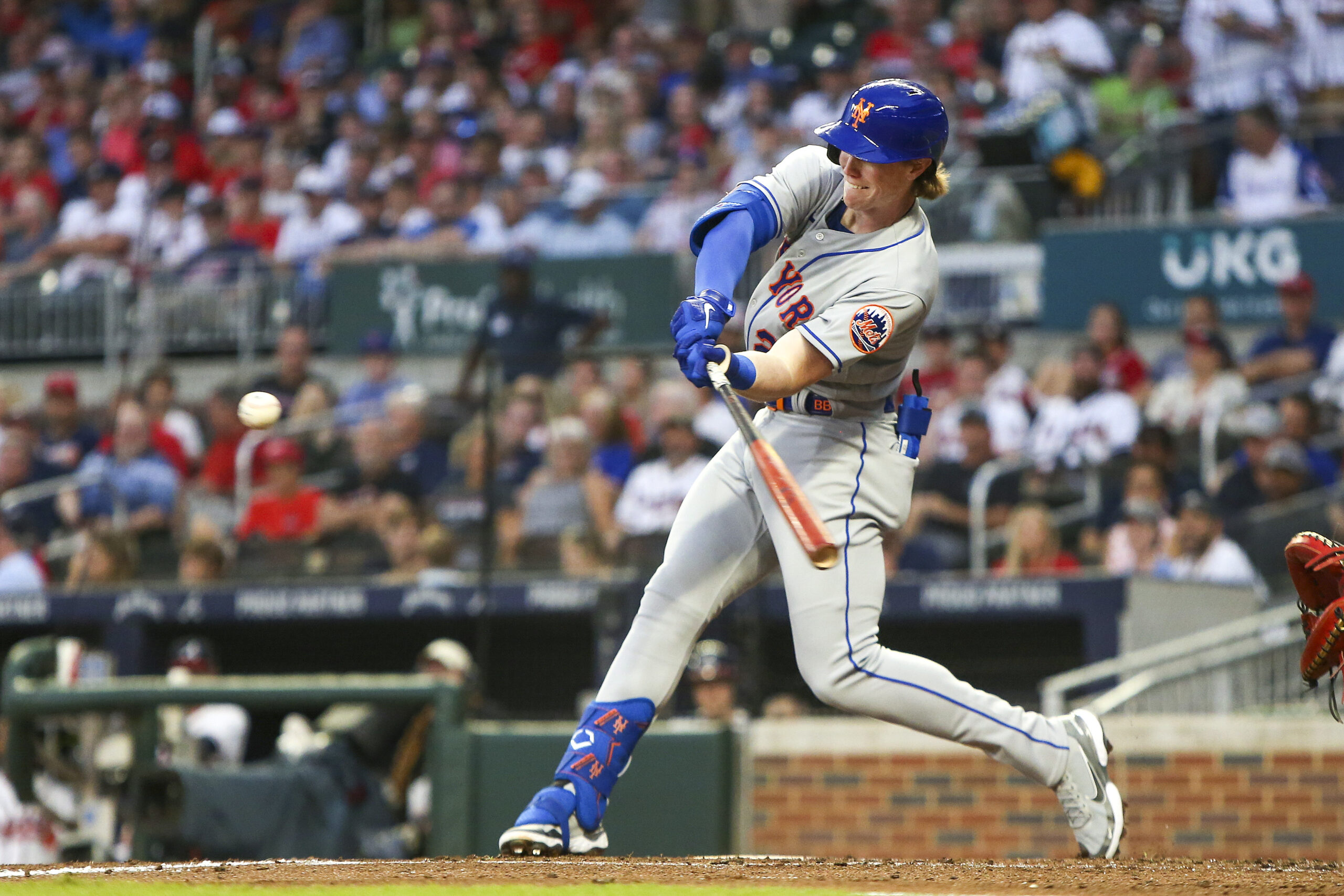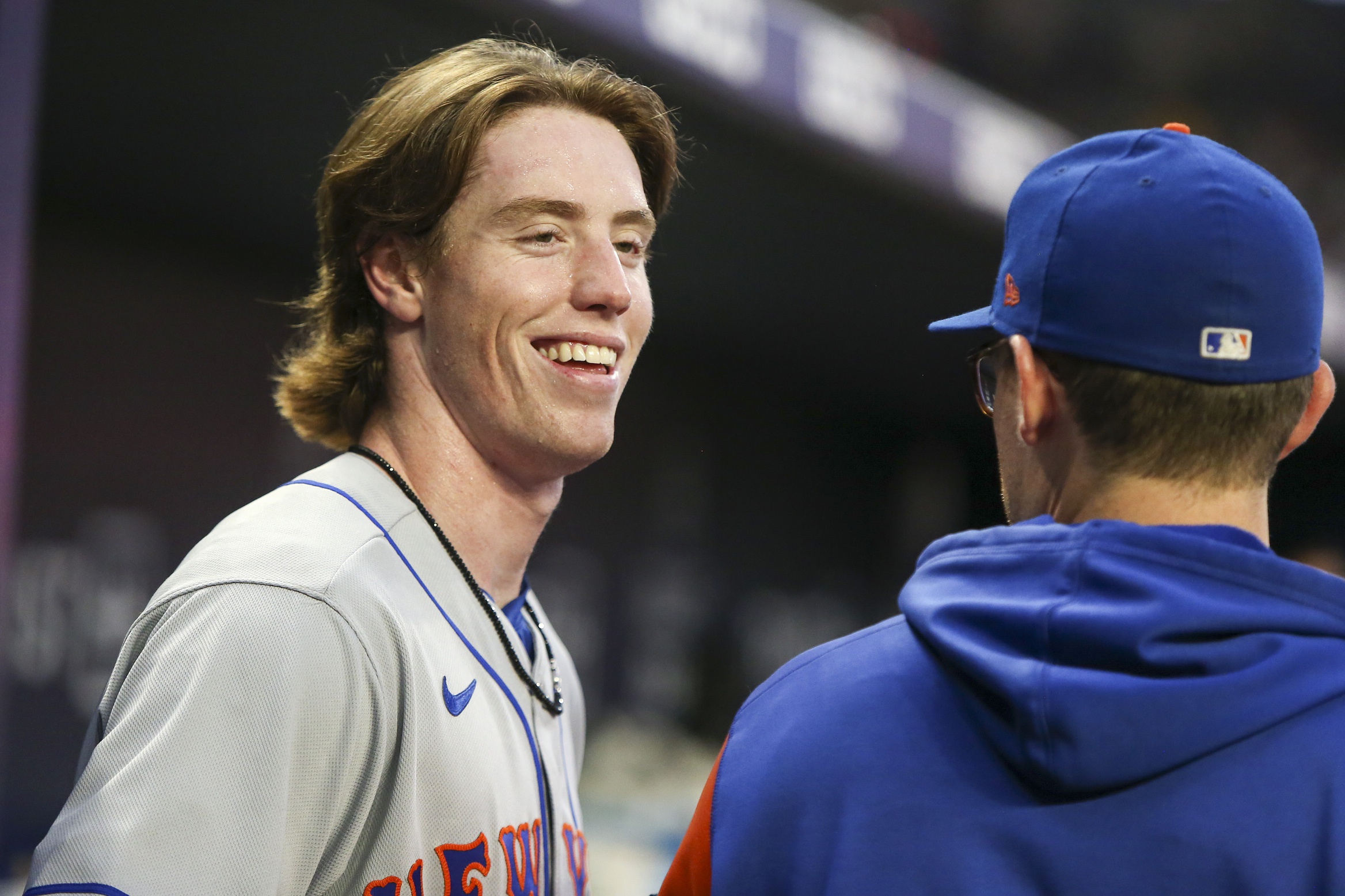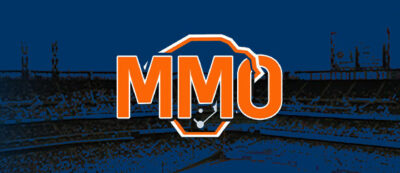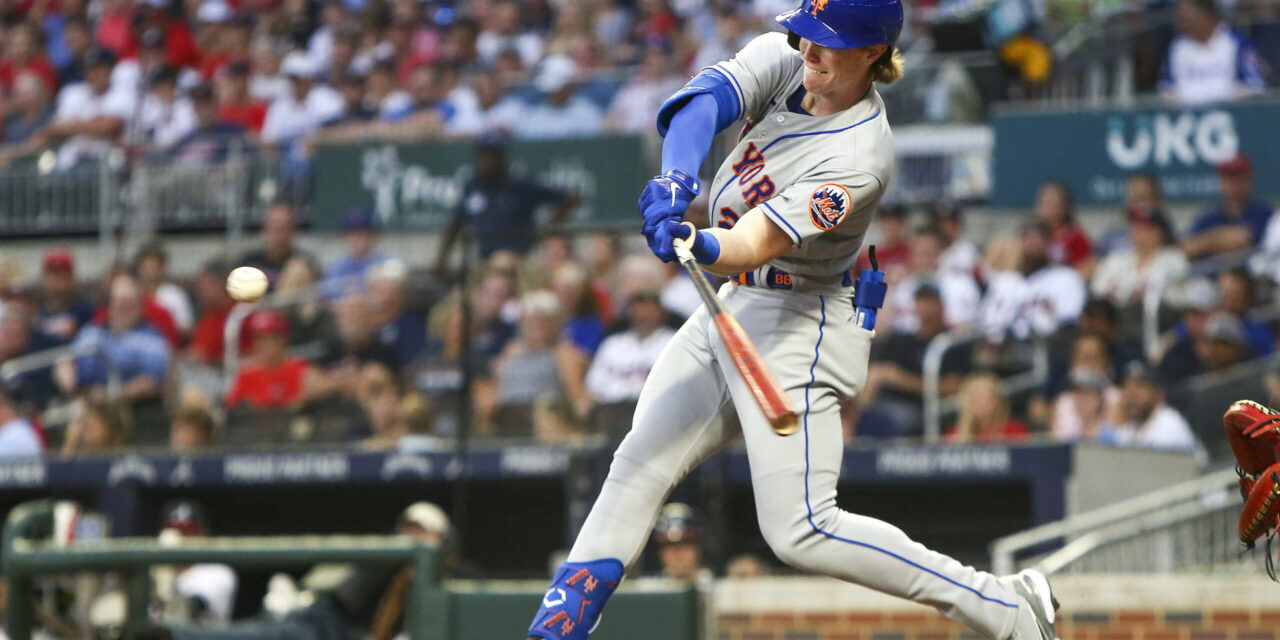Before the 2023 season, the New York Mets made the decision to option Brett Baty to Triple-A. In what seemed like blatant service-time manipulation, they stated that the third baseman had to achieve certain defensive benchmarks to merit a major league promotion.
However, when Baty started the season red-hot at Triple-A, the team reversed course. They brought Baty up on April 17 and inserted him into the lineup primarily against right-handed pitchers. By May, he was starting virtually every day.
At first, Baty appeared to be doing nicely. In his first 30 at-bats, he had 10 hits, including a home run and a double. However, he also had 10 strikeouts at a 33.3% rate. When he started getting regular playing time, things appeared to get progressively worse. Here are his month-by-month splits from May through July:
- May: 98 PA, 87 AB, .207/.286/.356 (.642 OPS), 4 2B, 3 HR, 12 RBI, 9 BB (9.2%), 20 K (23%)
- June: 81 PA, 74 AB, .257/.321/.338 (.659 OPS), 3 2B, 1 HR, 6 RBI, 7 BB (8.6%), 24 K (32.4%)
- July: 76 PA, 69 AB, .188/.233/.319 (.552 OPS), 3 2B, 2 HR, 5 RBI, 3 BB (3.9%), 24 K (34.8%)
Not only has Baty struggled mightily at the plate, but his defense has also steadily deteriorated. He has -5 OAA, per FanGraphs, which is the second-worst among third basemen and in the 17th percentile among 127 qualified fielders, regardless of position. His -8 DRS is in the ninth percentile among fielders, and his -10.4 UZR/150 is in the eighth. In other words, Baty has been a nightmare at third base, too.
What happened to the Mets’ prospect? Why has he struggled so mightily? While he is far from the first talented prospect to scuffle in his rookie season, the Mets must identify the specific issues he faces in order to correct them at the minor-league level.

Brett Davis-USA TODAY Sports
Failure to Elevate
One of the chief concerns regarding Baty as a prospect was whether he could learn to elevate the ball. Despite his clear power potential, he had a high groundball rate even in the minors. Indeed, Baty has hit 51.8% of his batted balls on the ground in 2023, per Baseball Savant, which is the 15th-highest rate out of 188 hitters (min. 300 PA).
Now, this alone is not a recipe for failure. There are 24 batters with at least a 50% groundball rate. Here is their breakdown by OPS (per Baseball Reference, the league average in 2023 is .733):
- Below .680: 9 (37.5%)
- .680-.732: 4 (16.7%)
- .733-.785: 3 (12.5%)
- .786-.838: 4 (16.7%)
- .839+: 4 (16.7%)
Thirteen of the 24 hitters are below average and 11 are above. Eight of them could even be considered decently above average, and four well above average. Players like Juan Soto, Yandy Díaz, Christian Yelich, and Masataka Yoshida fall into this category. Still, nine of the hitters are below a .680 OPS, which means they are performing significantly below average. Considering that Baty is hitting .230/.230/.240 (.470 OPS) on ground balls, it’s natural for him to fall into that category.
To take it a step further, when Baty hits hard ground balls, good things seem to happen. His BABIP on ground balls with an exit velocity of 95 mph or above is .424, and he’s done so 17% of the time. The bigger problem is that 24.7% of his groundballs are soft (below 88 mph) with an average exit velocity of 71.6 mph, and he’s hitting .125 on those balls.
It’s not easy to succeed when hitting the ball on the ground so often. Baty’s 5.9 average launch angle is in the ninth percentile in all of baseball, far worse than his 10-degree angle in his 2022 cameo. This doesn’t appear to be a simple issue to fix.
Strikeouts
Baty is swinging and missing an extraordinary amount, as he ranks in the 19th percentile in whiff rate. That has contributed to a 27.7% strikeout rate, which is in the 17th percentile among batters.
Striking out a lot is par for the course for many power hitters. J.D. Martinez and Luis Robert Jr. are two hitters having excellent seasons while striking out at a higher rate than Baty. Still, a groundball hitter can’t also strike out a lot. Martinez ranks sixth in all of baseball in fly ball rate, and Robert is in the 77th percentile. Meanwhile, hitters like Soto, Díaz, Yelich, and Yoshida are all at least average in strikeout rate; Yoshida has the seventh-lowest rate in all of baseball at 11.7%.
Combining a high groundball rate and a high strikeout rate will usually yield poor results. I don’t think this is the chief issue plaguing Baty, but it certainly hasn’t helped.
He’s Not Hitting Breaking or Offspeed Pitches
It is typical for young hitters to struggle against breaking and offspeed pitches. Still, Baty is not hitting nearly well enough against fastballs to be able to survive those struggles against other types of pitches.

courtesy of Baseball Savant
Baty has whiffed at 42.3% of the breaking balls he’s seen while hitting .167 against them. Why would anyone throw him anything else with two strikes?
Not Swinging
Despite Baty’s high whiff rate, his refusal to swing is just as big of an issue. The Mets are stressing plate discipline in their hitters, but it’s resulting in them taking many strike calls. Baty is swinging at just 63.7% of pitches in the zone, which is in the 28th percentile among batters. He joins Pete Alonso as a hitter who is also not swinging at pitches in the strike zone.
Interestingly, while waiting for the “perfect” pitch to hit, both batters are laying off more perfect pitches to hit than they should. Baty has seen an 8.2% meatball rate, which is higher than 83% of hitters in baseball. However, he’s swinging at just 70.7% of those pitches, which ranks in the 18th percentile. Just below him is Alonso, swinging at 69.2% of the meatballs he’s seen (although he’s seeing them at a below-average 7.2% rate).
This is something to blame on the Mets’ coaching. They’re so insistent on being selective that they’ve made their hitters afraid to swing. Baty and Alonso are the two poster boys for this. Just as Alonso’s 43.3% swing rate, the lowest of his career, has contributed to what could be his career-worst season, Baty’s 45.3% rate is hurting him. These are hitters who need to attack. They have mistaken plate discipline for simply not swinging.
Lack of Adjustment
Baty is actually hitting very well against starting pitchers the first time he faces them. However, as they come around the second and third time, his hitting worsens. He’s also performed miserably against relief pitchers.
- SP, first time: 76 PA, .296/.329/.479 (.808 OPS)
- SP, second and third time: 95 PA, .222/.316/.321 (.637 OPS)
- RP: 140 PA, .167/.245/.254 (.499 OPS)
This could simply be a case of small sample sizes. It could also be starting pitchers and relievers throwing more breaking pitches as they move through the game. However, it also seems to be a lack of counter-adjustment as the pitcher adjusts to Baty.

In His Head?
Baty’s home/away splits are wildly extreme. At Citi Field, he’s been a competent hitter; on the road, he’s well below replacement level.
- Home: 144 PA, .254/.317/.485 (.802 OPS), 1 XBH/9 PA, 1 HR/20.6 PA, 33.1% K%
- Away: 167 PA, .182/.265/.196 (.461 OPS), 1 XBH/83.5 PA, 0 HR, 29.1% K%
If Baty had hit only at Citi Field this season, Mets fans would be excited about his future. Instead, he was demoted. Why are these splits so stark? Hitters often struggle at Citi, especially power hitters. Baty, by contrast, can’t hit away from his home ballpark.
Additionally, Baty’s numbers when leading off an inning and with no runners on base are decent.
- Leading Off: 64 PA, .250/.344/.464 (.808 OPS)
- Bases Empty: 185 PA, .224/.317/.410 (.727 OPS)
- Men On: 126 PA, .205/.248/.222 (.470 OPS)
- Batting 8th or 9th: 93 PA, .289/.333/.434 (.767 OPS)
While his numbers with the bases empty are certainly nothing to write home about, they are competent enough to have kept him in the majors. That leads to the question of whether he’s thinking too hard in situations where he’s not comfortable.
This further bears out from Baty’s defense. Earlier in the season, he made the occasional blunder but appeared mostly comfortable at third. However, as his hitting struggles have mounted, his fielding has regressed to much of what we saw from him in 2022.
A recent article by Mike Puma of the New York Post quoted Baty as saying, “You’re under a microscope up here, so you have got to be engaged from Pitch 1 to the end of the game. That is something I have got to work on and something I have got to learn, so I am going to do my best at it.” Puma implied that Baty is accustomed to taking pitches off in the minors, but I don’t believe that’s what Baty was trying to say.
Mental and emotional fatigue does not mean that the player is a slacker. I suspect that Baty is simply trying too hard and getting into his head too much. In 2021, Mets batters complained that the analytics department was causing information overload. It seems that this might be the case with Baty, forcing him to think too much rather than playing fast and loose.
Puma’s article also noted that Baty is working on pitch selection with hitting coach Jeremy Barnes. Perhaps that begs the question about where the fault for Baty’s struggles lies, especially in light of the above data about Baty’s swings (along with much of the Mets’ lineup).
What Can He Do About It?
It appears that Baty’s season will finish in Triple-A. The problem is that even if he knocks the cover off the ball there, we’ve heard that song before. That could just mean he’s a Quadruple-A player.
Rather than plate discipline or anything else, Baty’s chief concern should be to stop hitting the ball straight into the ground. Per Baseball Savant, the sweet spot for a batter is a launch angle between 8-32 degrees. Notice that anything below 10 degrees is considered a ground ball, so a batter can technically get the ball off the sweet spot and still hit it on the ground. However, Baty’s sweet-spot rate has diminished from 43.3% in 2022 to 32.6% in 2023 (30th percentile), even though his groundball rate is actually down by 5% and he rarely pops up.
Furthermore, more than plate discipline—choosing which pitches not to swing at—Baty’s focus should be on pitches to swing at. Rather than seeking to lower his strikeout rate and increase his walk rate, he should be looking for good pitches to hit, period. Unfortunately, that doesn’t seem to be the Mets’ way of teaching their hitters.
As far as his defense, it could simply be that he’s not cut out to play third base at the major league level. That was a concern the Mets had when he was originally in the minors and why there were rumors that they would try to move him to left field. Switching his position while he’s struggling so much at the plate likely isn’t wise, but he needs to get out of his head defensively, too. In fact, it’s possible that more offensive success will help him slow down once more, as he seemed to do in spring training.
Additionally, perhaps Baty—and all the other Mets—could use a sports psychologist. Just as athletes train their bodies to reach a peak level of performance, taking care of themselves mentally and emotionally can help them withstand the rigors of a long season.
This is not the 2023 season anyone, least of all Baty, was hoping for. Still, perhaps he can turn the page along with so many other Mets and find his way back to successful baseball.















